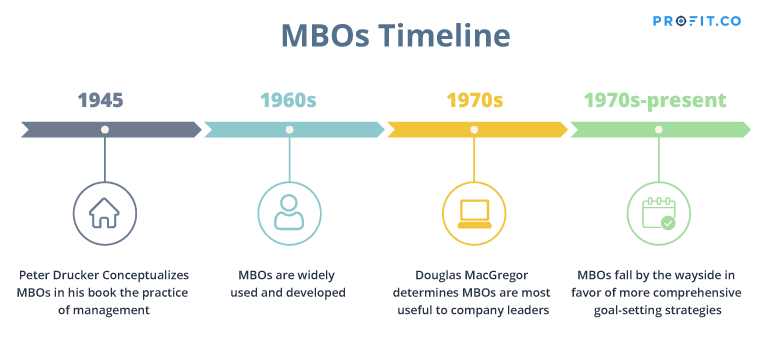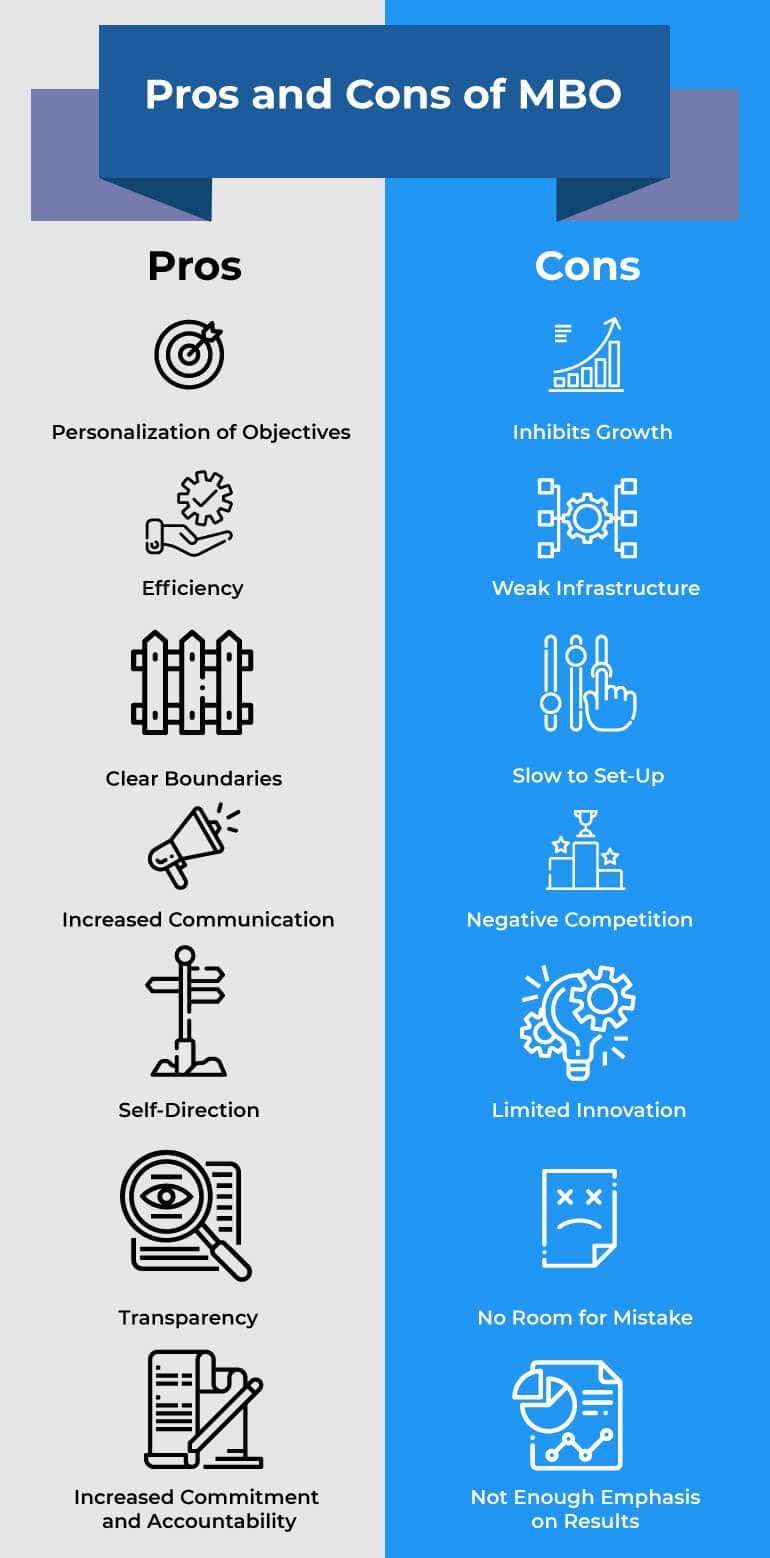Organizations of all kinds need effective management frameworks to follow in order to best reach their individual goals. Management by Objectives is one such framework that aims to create a cohesive communication between all associates within a company, from the management to the employees.
Most impossible goals can be met simply by breaking them down into bite size chunks, writing them down, believing them and going full speed ahead as if they were routine.
Management by Objectives, also known as MBOs, is a strategic model used by organizations to clearly outline specific objectives and major company goals that are agreed upon by both management and employees. The process of MBOs consists of five steps that aim to enhance performance.
In this article we will explore the origin of MBOs and the key steps within its process. We will also discuss other components on MBOs such as the three types of objectives, the pros and cons of this strategy, examine real life examples, and dissect how MBOs compares to other modern performance management system.
The Origin of MBOs

The theory of Management by Objectives was first described by Peter Drucker in 1954 in his book The Practice of Management. This original outline was further developed throughout the 1950s to 1970s, which was also the timeframe in which it was most commonly used.
The Management by Objectives model runs off the principle that a company’s effectiveness is a more important skill than its efficiency. This puts a focus of management on the quality of performance rather than speed. One of the later developers of the model, Douglas MacGregor, insisted that MBO as a system was better at helping the superiors of a company more effectively assess their subordinates.
After the 70’s, however, widespread usage of MBO largely decreased, especially as new styles and systems of management began to be developed. There was some critique that MBO was simply not a comprehensive enough system of management, especially in the sense of MBO being too short-sighted, according to HR Zone.
Has MBO Become Obsolete?
Despite its fall from popularity, MBO is still a system of management that is utilized, either in whole or in part, by many companies. There are many principles laid out within MBO that can be seen echoed through more modern management styles, as MBO focuses tightly on the core aspects of performance management.
As such, MBO is still an important management model to examine for companies today. The principles outlined have the potential to work as solid tools within a broader scope of knowledge about management styles.
The Key Steps and Components of MBO
The MBO system is defined by five steps, but there are actually a few additional components to consider. Each of these do come into play in the steps but may require extra attention or reorganizing in the event that the system seems to be non-effective.
These additional components are the types of MBO objectives, quantification of objectives, and performance appraisals. Each of these contributes not only to the success of MBO but to the greater organizational understanding of the wants and needs of a company.
The Five Steps
1. Set Company Objectives: A company’s management team must identify clear and measurable goals that are within a reasonable realm of achievement and align with the company’s mission, ideals, and ethics.
2. Translate Objectives to Employees: The objectives, once decided upon, must then be delivered to and aligned with employees of the company.
3. Employees Set Individual Objectives: Once given the broad company-oriented objectives, employees should plan their own personal objectives that will help them to arrive at the larger company goal
4. Monitoring of Employees: The employees are now monitored by management for how well they perform and deliver on both the agreed upon individual and company objectives.
5. Evaluation: The final step is an evaluation and provision of feedback for employees by management. Those doing well and staying on track with the objectives are rewarding, providing incentive for employees to stay focused and work hard.
The 3 Types of Objectives
Generally speaking, objectives within any sort of strategic management can be divided into three overarching categories. These apply to MBOs objectives, but they can also apply to objectives in different management systems and scenarios as well. They are as follows:
1. Strategic Objectives: These are the broad, all-encompassing objectives determined by company management in step one. These should always be set first and then used to determine later objectives.
2. Tactical (Team) Objectives: These are more specific objectives within a company that set groups or teams should work towards accomplishing. This can include tasks that require teams from different departments to intersect and collaborate to achieve a common goal.
3. Operational (Individual) Objectives: These are highly-specific goals that belong to either an individual employee or to a singular department. These objectives will vary greatly from person to person depending on what their overall role in the larger objective is.
Quantification of Objectives
Quantification of objectives is providing a clear outlining and definition of the requirements of the specified objective. This can be simplified by the use of the acronym SMART, which means:
- Specific: The objective should exist within a well-detailed set of parameters with a clear target in mind.
- Measurable: Progress carried out by the employee or department should be documentable or measurable, meaning clear milestones are being assigned and completed.
- Achievable/Assignable: The objective should be achievable by a certain employ or department. This also means the company must have proper staff or department available to assign the objective to.
- Realistic: The objective should have an expectation of results within reasonable limits given the amount of time and resources available.
- Time-Bound: The objective should be set within a specific time period with a clear deadline outlined.
Performance Appraisals
The final step involved in MBO are the performance appraisals, or evaluations. Like the other components, there are multiple layers to a performance appraisal that must be considered in order for them to be effective, such as:
- Initial Evaluation: The manager or management team observes and assesses employee productivity and objective achievement.
- Feedback: Management discusses the evaluation with the employee, providing useful and valuable feedback on the employee’s strengths and weaknesses, and how to improve.
- Reward: Employees who have done well with their objectives will be adequately rewarded. These rewards also serve as incentives for others to complete higher quality work.

Pros and Cons of MBO
Arguments both for and against MBO exist today. As mentioned earlier, some critiques of MBO include the idea that the system is too short-sighted in terms of business growth and productivity. This is due to limitations brought on by setting objectives too strictly and not allowing for natural innovation amongst employees.
According to Harvard Business Review:
“With pre-established goals and descriptions, little weight can be given to the areas of discretion open to the individual but not incorporated into a job description or objectives”
However, others argue that when MBO is used as a tool within a larger and more comprehensive management plan, it can greatly help to simplify management and optimize it for efficiency.
The truth of the matter is the MBO comes with both advantages and disadvantageous. Being aware of its strengths and weaknesses is key in utilizing the system as effectively as possible. Below are outlined the main pros and cons of Management by Objectives:
Pros
- Personalization of Objectives: Employees are given tasks that fit their specific skillsets and best employ their individual strengths, rather than having to focus on a myriad of tasks that may not be as knowledgeable of.
- Efficiency: The highly structured nature of MBO plus the requirement of quantifying the objectives to be time-bound tends to lead towards higher levels of productivity and efficiency.
- Clear Boundaries: The extent to which objectives are discussed amongst both management and subordinates makes for clear-cut expectations and boundaries for employees to follow.
- Increased Communication: MBO requires detailed discussions between company associates at all levels in order to run smoothly. Thus, employee to employee, employee to management, and inter-management communication is all improved and heightened.
- Self-Direction: Thanks to MBO requiring employees to establish their own personal and individual objectives in order to reach the greater business goals, employees tend to be more self-directed in day to day activities.
- Transparency: MBO requires a break down of all elements and task required in order to achieve an objective. Moreover, it requires companies to be totally transparent about their main objectives with employees.
- Increased Commitment and Accountability: The structure, communication, and transparency of MBO helps to strengthen the commitment of employees by giving them a clear idea of their role. Additionally, higher levels are accountability are seen thanks to the personalized nature of individual objectives.
Cons
- Inhibits Growth: Due to employees staying within their clearly set lanes of tasks and production, there is limited opportunity for them to grow outside their comfort zones.
- Weak Infrastructure: The focuses on broad objectives and company goals can lead to a negligence towards company infrastructure and mundane operations. This can in turn lead to errors and mistakes by employees unsure how to resolve issues within the infrastructure of the business.
- Slow to Set-Up: While the overall system of MBO can ultimately make the achieving of objectives more efficient, the process of establishing and agreeing upon objectives can become quite lengthy if management has difficulty deciding upon the most important goals, and can thus cancel out the aforementioned efficiency.
- Negative Competition: The evaluation and reward system has the potential to cause tensions between employees. This can lead to negative competition wherein employees begin to be less cooperative and communicative with each other in order to try and best one another.
- Limited Innovation: Because employees decide upon their own set of objectives, this can lead to them becoming to narrow-sighted and unwilling to try out creative or innovative solutions when problems arise if those solutions stray outside of the rules and boundaries that have been set for them.
- No Room for Mistakes: Managers may begin to expect too much precision and perfection from employees, making small errors or mistakes suddenly seem like much more drastic issues.
- Not Enough Emphasis on Results: The steps of MBO may lead to too much emphasis being placed on the setting of objectives rather than the planning and execution of strategy on how to reach that objective.
Real-World MBO Examples
There are many fields that can utilize and potentially benefit from MBO. Here are some real-world examples of how MBO can be used:
- Human Resources: MBO can be used for such things as improving employee satisfaction, hosting company events, or increasing employee engagement.
- Company Performance: Using MBO to increase gross margins, reduce carbon footprints, expand sales, etc.
- Marketing: Goals achieved with MBO can include increasing newsletter subscription, increasing social media following, and doubling web traffic.
- Customer Support: Reducing incident rates, improving availability of associates to aid in customer conflicts, and increasing speeds of conflict resolutions.
In truth, all aspects of a company – from human resources to marketing to sales to information technology and everything in between – can benefit from clear objective setting in areas where the company may currently fall short.
How MBO Compares to Alternatives
MBO paved the way for many modern-day and commonly used management systems. Here are three popular alternative styles and systems of management and a brief description of what they entail:
- OKR (Objectives and Key Results): OKR also focuses on objectives, like MBO, but according to Bernard Marr & Co., it takes the process further by breaking down strategy and execution more comprehensively. This management system focuses not only on objectives but on key results that build up to the achievement of the objectives.
- SoPK (System of Profound Knowledge): SoPK was developed by Dr. W. Edwards Deming. The primary goal of this system of management is to “provide a framework of thought and action for any leader wishing to transform and create a thriving organization, with the aim for everybody to win,” according to NHS Foundation Trust. This system focuses much more heavily upon quality knowledge and leadership.
- Scorecard Management: Similar to the evaluations of MBO, scorecard management focuses on tracking, monitoring, updating, and improving key performance indicators within an organization, according to Lumen Learning. These evaluations are considered much more diversified and comprehensive than those offered by MBO.
Final Thoughts
Though Management by Objectives is a bit outdated, it can serve as a great foundational point and tool within a larger toolkit for many companies looking to improve their style of management. MBO focuses on objectives and setting up employees for high productivity and success. Management teams should just be wary of becoming too narrow-sighted when using MBO and stay alert to potential complications that may arise. Additionally, integrating MBO with modern performance management software can enhance its effectiveness by leveraging technology to track, monitor, and evaluate objectives more efficiently.

